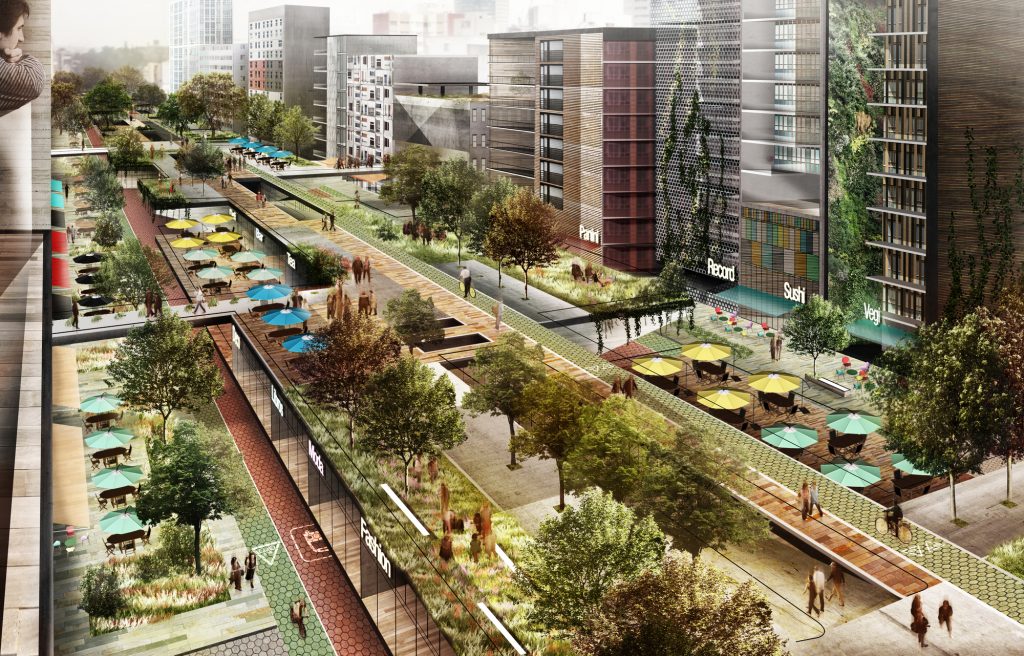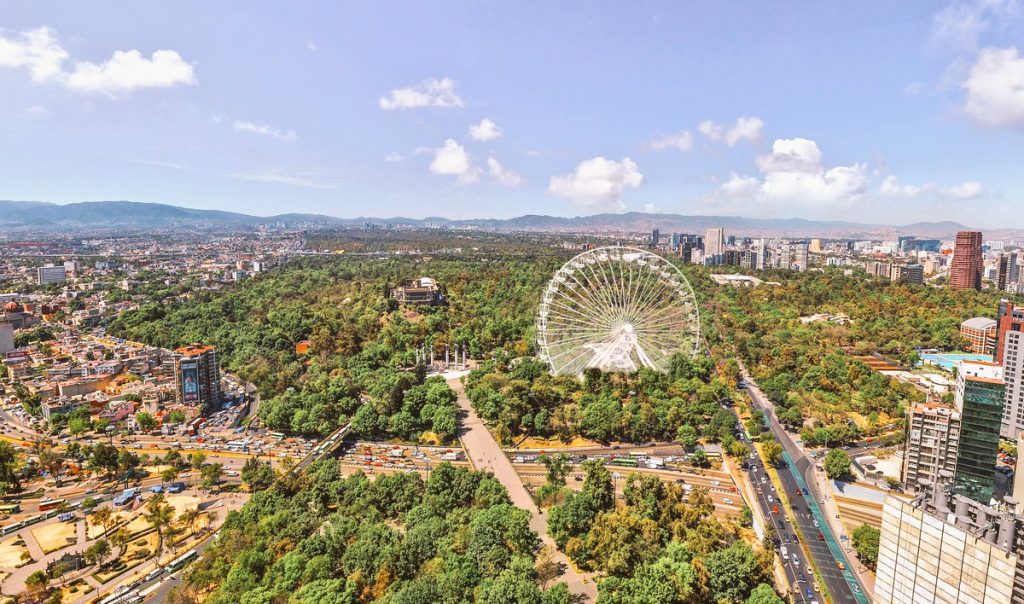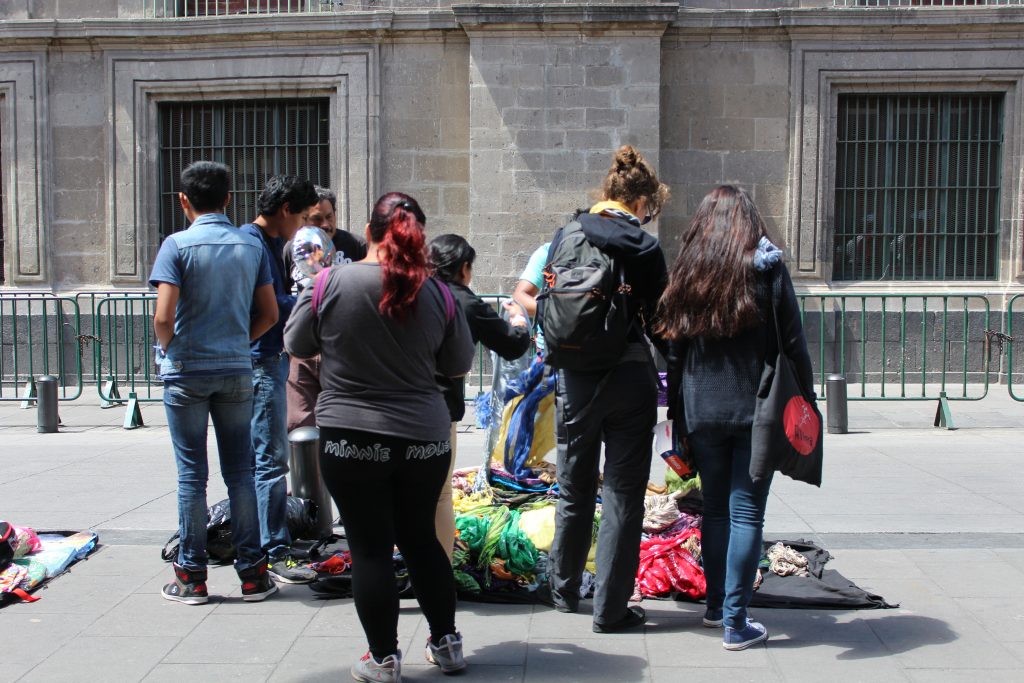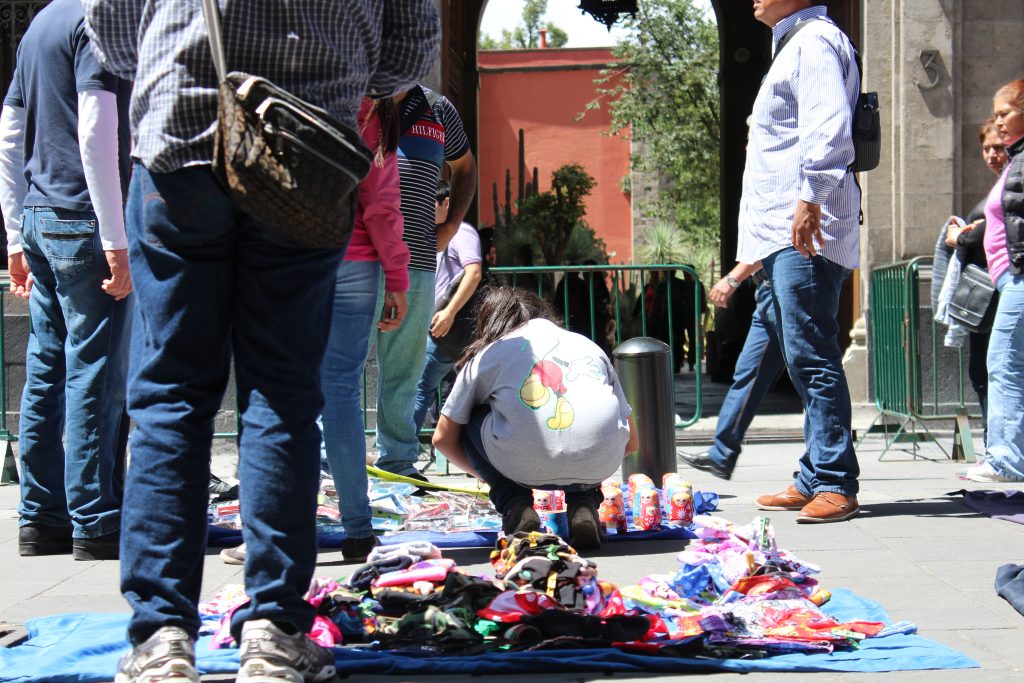
Public Space and Democracy in Mexico City: Privatizating Public Space
We are proud to present this guest post by urban planner and researcher Guillermo Bernal, founder of the Mexico City consulting firm Lugares Publicos and a member of Taller Participativo Barrial.
The Mexican tradition of the “tianguis,” or open-air market, dates to pre-Columbian times. Every important city had a tianguis where, on certain days of the week, the public plaza was occupied by stalls offering a wide variety of food and other products, as well as services. People came from surrounding towns, and sometimes from very far away, to buy and sell. The tradition of open-air commerce in public spaces was continually adapted during the colonial period and into the present. Today’s tianguis is an open-air bazaar much like the busy Moroccan souk, with a waiting list of vendors similar to the Portland Farmer’s Market or the Union Square Greenmarket in New York City. A notable peculiarity of urban tianguis in Mexico City is their open illegality, selling untaxed (and sometimes pirated) products in front of the police and official city buildings.
Tianguis can be seen in many typologies around the city. In La Roma, for example, a small organic tianguis operates on Sundays inside the former headquarters of a defunct political party. Most, however, are held outside in public spaces. These are organized in union-type structures, where a leader collects fees from each vendor and negotiates informally with police and borough authorities on behalf of the vendors. In exchange for a percentage of the leader’s take, the authorities look the other way. These funds form an important part of any borough politician’s campaign funds. Tianguis union leaders are also key political players in their own right. They are often associated with political parties, controlling specific territories and using “their” vendors as a political resource. In addition to the quotas vendors pay for their spaces, they are required to attend political events and marches and to vote for the leader’s party. These structures differ in size and power, depending on where they are located and how much money they can collect in fees. For example, a large tianguis near public transportation is more profitable. And in a city as crowded as Mexico City, the largest tianguis often block major thoroughfares or take over public parks on market days.

Tianguis in Ixtapalapa, Mexico City
Source: Lugares Públicos A.C.
The operation of the tianguis responds to a well-established informal economic model and the political/electoral system in the city. This system is complex and underground enough to be misunderstood in a love-hate kind of way. Residents like having access to fresh fruits, vegetables, and other products practically on their doorsteps. Visiting the local tianguis and enjoying street food is also a popular weekend pastime. But tianguis also generate garbage, noise, crowds, and traffic, and the political power of tianguis leaders makes them nearly impossible for neighbors to negotiate with.
A typical theme around tianguis and street vendors that emerges in the daily dialogue between neighbor committees and the local government is the notion that they are privatizing public space for the sake of political and economic profit. Neighborhood committees are generally opposed to tianguis and street vendors. This includes both legal activities such as food trucks, as well as illegal ones such as “chelerías” (beer gardens), since both public drinking and the sale of pirated products (bags, sunglasses, DVDs, etc.) are illegal. Street food stands are also not subject to health inspection. Street vending is notoriously hard to control, however, and stalls tend to pop up wherever there are flows of people. Data from neighborhood committees of the Cuauhtemoc borough give an unofficial count of more than 100,000 street vendors (the official population of the borough is around 530,000).
The tianguis is a long-standing tradition, but its saturation of public space in zones outside the historic downtown is more recent. In the 1980’s, neoliberal reforms and the devaluation of the peso kicked off a long downward decline in formal employment, which continues into the present. With each successive economic crisis, more and more residents of the megalopolis are forced onto the street to make a living in the informal economy. In the early 1990’s, as head of the government of Mexico City, Manuel Camacho Solis began to encourage and manipulate the vendors’ unions in order to forge an independent political resource that he could use to promote himself within the structure of the PRI. While he did not achieve his ultimate goal of garnering the party’s presidential nomination, his strategy had unintended consequences. Today there is an underground economy accounting for 25% of the GDP (according to research from INEGI, Mexico’s National Institute of Statistics and Geography) which employs around 31 million people in both drug related activities and street vending in mayor cities, without any taxation scheme. It is clear that the Mexican economy and political landscape cannot be fully understood without considering drug related activities, but street vending should also not be underestimated for the political capital it represents. Political leaders are always tempted to give more space to vendors. After the latest change of power in the central government in Mexico City, the new mayor received threats and a bag with 1.5 million pesos nicknamed “El Niño” in exchange for not touching the vendors’ interests. He reacted by publicly giving the money to the police and opening an investigation into the matter.
Street Vendors in front of the National Palace, Mexico City
Source: Lugares Públicos A.C.
Food Trucks
The food truck phenomenon is close to Mexico City´s “hipster” movement. The Roma-Condesa district in Cuauhtémoc is the epicenter of the movement with gentrifying tendencies such as galleries, vegan cafes and the arrival of food trucks. The latest hot spot for the food trucks is around where nightclubs and creative offices are located. However, the food trucks have had more difficulty getting official approval than traditional street vendors, who are backed by a more established organizational structure.
The neighborhood associations treat food trucks as another form of street vending. However, food trucks lack the political structure of the tianguis, and they are generally pushed out by the local government for not having a permit or simply because they refuse to pay quotas to local tianguis leaders. Food trucks stand to improve the quality of life in such areas with higher standards in food preparation and a wider variety of products, but many city institutions view them as a privatization of space and a symbol of gentrification that threatens traditional street vendors.
#CCChapultepec #Shopultepec

Render from Chapultepec Cultural Corridor
Source: www.ccchapultepec.mx
The controversy over street vending has led some free market liberals to propose solutions such as “shopping-malling” streets, replacing temporary stalls with more upscale, formal commerce. The latest attempt at this sort of project was the “Chapultepec Cultural Corridor,” rejected by voters earlier this year. The idea was a thinly-disguised copy of New York’s High Line Park (if the High Line were built from scratch atop an 8 lane urban artery instead of defunct railway tracks), combined with a generic million square foot shopping mall. The rhetoric was fantastic and absurd at the same time. Government officials in charge of the project in ProCDMX (Investment Promotion Agency and Development for the City, a public-private partnership) were campaigning that there would be no privatization of public space but developing a strategy with a public-private trust that was structurally unequal, given that only 5% of revenues would go to the city with a 40 year operating permit.
Activist groups such as TPB (Taller Participativo Barrial) joined many other architects, urbanists and neighborhood associations in public hearings, first to understand the project and then to push for a real participatory process, which was the main agenda of TPB. The movement on Twitter was called #Shopultepec, as opposite to the “cultural” branding of the project by city officials. City government leaders seem to have been taken by surprise. This movement generated such an impact that the head of the ProCDMX office finally conceded to public demands for a referendum. People from all over the Borough of Cuauhtémoc voted against the project 4 to 1, including not only activists and neighbors but also street vendors living in the more underprivileged areas.
It´s still not clear how the public movement and street vendors managed to influence the hearing, but the general agreement is that people rather dislike this kind of privatization of public space and the simulated process of “participation” that took place prior to the referendum.
Wheel of Fortune Chapultepec #RuedaCDMX
In Spanish, a Ferris wheel is called a “wheel of fortune.” This is an extraordinary metaphor for the luck public space is having under the current city government. Earlier this year, the city government announced that an enormous Ferris wheel would be constructed on a 1,770 square meter site, in Chapultepec Park. The park is Latin America’s largest urban green space, measuring in total just over 1,700 acres, and has been under constant threat from encroachment by developers. The proposed wheel was to be constructed near the National Museum of Modern Art, just yards from Chapultepec Castle and would transform the skyline with another copycat project. Similar to the Chapultepec Cultural Corridor project, it is being promoted by a public-private partnership formed under suspicious circumstances and on very disadvantageous financial terms for the city. Neighbors from surrounding zones and environmental activists are campaigning against the project on the grounds that it will damage already endangered green space and attract yet more illegal street vendors to the area, generating yet more trash and traffic. Like the CCC project, it has also been criticized as a crass commercialization of public space. Recently, city leaders announced that the project will be relocated somewhere outside of Chapultepec Park, but there are no plans of cancel it outright.

Render from the Wheel of Fortune in Chapultepec Park
Source: Twitter @TParticipativo
It´s no surprise that this project also lacks a real participatory process. For example, the proposal team only used a 14-person spectrum for their opinion poll, but did a complete financial study to calculate the viability and the revenue skim!
There is a feeling of imposition associated with all of these new public space projects in Mexico City. There is no clearly published information on the project regarding its impacts on control and exclusion in the use of public space use. But, as with any social movement, neighbors opposed to the project are complaining, asking for information, organizing counter-campaigns, and participating in social networks more intensely than ever using another hash tag: #NoaLaRueda. However, their counter-campaign might not be as successful as with #Shopultepec, since the city government learns how to better undermine these movements each time.
Shades between public and private
In the first part of Ben Shepard and Greg Smithsimon’s Beach Beneath the Streets (2011) the authors propose a typology of public spaces where on one axis there is the question of who controls the space (private owners, current users or government) and in the other who is invited to use the space (everyone, selective group or none). The result is a gradient of public-ness.
This typology helps us easily enough understand New York City´s evolution of public space, but it can also be applied to many cities in transition and development such as Mexico City, where still rules of the institutions and public spaces are not well written. Understanding who controls the space and who is allowed in it can help us understand the most suitable public policies.

Youth buying from a street vendor
Source: Lugares Públicos A.C.
It is clear that the current Mexico City government lacks the capacity, both technical and institutional, to generate a participatory decision-making process. This is compounded by the lack of commitment from officials. The rules of who controls public space, and how to operate it are still not clear.
The future looks complicated for groups seeking a participatory process in public space decisions. But there´s a chance that the new constitution to be approved in 2017 might bring about some change in favor of street vendors, neighbors and urban activists who are also looking for their place in the discussion.
The traditional and new forms for the local economy to use public spaces represent a challenge and an opportunity to improve city life. In the future we will write further about the struggles around the city´s new constitution and the fight for representation exemplified by the groups in power who want to control public space.





